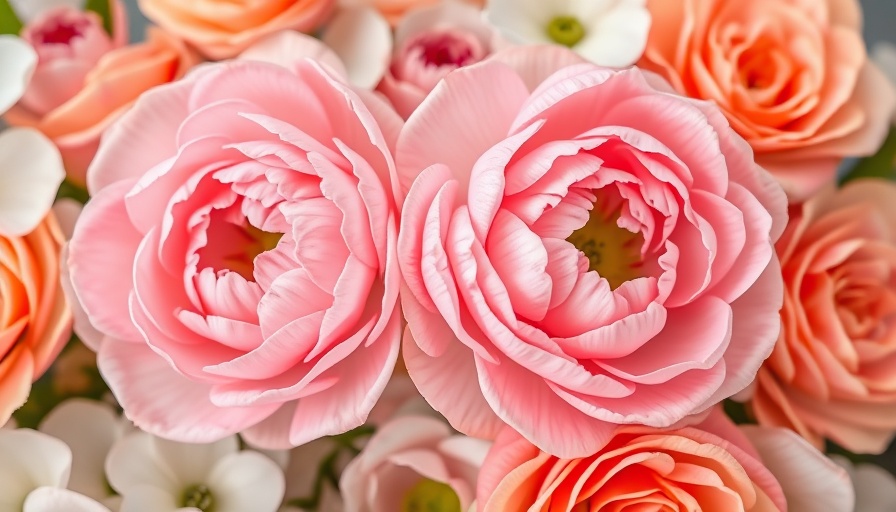
Beautiful Blooms: Discovering the Delight of Growing Ranunculus
As the vibrant colors of spring approach, gardeners everywhere find themselves excited by the prospect of adding ranunculus flowers to their collections. Known for their large, lush blooms and myriad color options—from soft blush to deep wine red—these flowers can truly transform any garden space into a visual feast. For those who love to bring a bit of extra cheer into their lives and surroundings, ranunculus offers a delightful choice that captivates the heart.
Why Choose Ranunculus?
The ranunculus, also commonly referred to as the Persian buttercup, is a beloved garden flower. Their delightful, tissue-thin petals create a striking appearance, often leading people to think they resemble miniature peonies. With over 250 species, the most popular variety for home gardeners is the Ranunculus asiaticus, which boasts hybrids like the Tecolote that are well-suited to garden settings. Perhaps the best part is that these flowers are not just beautiful; they are remarkably simple to grow from corms, making them accessible to all gardening enthusiasts, regardless of experience.
The Basics of Planting Ranunculus Corms
Before jumping into planting, it’s important to understand how to prepare for planting ranunculus. Corms, which resemble small octopuses with scraggly roots, require proper preparation for optimal blooming. To successfully grow them, cultivators should start by soaking the corms in lukewarm water for a few hours prior to planting. This enhances hydration and encourages germination. Gardeners can begin this process indoors in late winter for a head start on the blooming season, or opt to plant them directly into the garden once temperatures warm up.
Timing is Key: When to Plant
Deciding when to plant ranunculus largely depends on the local climate. In areas with milder winters (hardiness zones 8 and above), gardeners can achieve stunning results by planting corms in the fall, allowing them to establish roots before winter. However, for many, spring planting is the more accessible option. Monitoring soil temperature is vital; ideally, the ground should reach about 60°F for successful growth. This consideration significantly influences the timing of blooms, with earlier planting leading to a longer and more fruitful flowering season.
Caring for Your Ranunculus
Once planted, caring for ranunculus involves a few straightforward steps to ensure healthy plant growth. Regular watering is essential but should be balanced to prevent over-saturation, which can lead to rot. Additionally, applying mulch around the plants can help retain soil moisture and suppress weeds. Fertilizing with a balanced organic fertilizer can also promote robust growth, especially when done early in the growing season. For those who wish to cut blooms for arrangements, be sure to do so in the morning when the flowers are at their freshest. This practice not only maximizes longevity but also makes for beautiful displays in your home.
Ranunculus: A Flower for Every Space
Beyond their traditional garden settings, ranunculus flowers also thrive in containers, allowing urban gardeners to enjoy their beauty, even in limited spaces. They can be incorporated into various garden designs, from vibrant flower beds bursting with color to minimalist arrangements focused on texture. Whatever your style, ranunculus can adapt beautifully to suit your preferences.
Incorporating Ranunculus into Your Garden
If you’re thinking about expanding your garden or redesigning a part of your outdoor space, consider incorporating ranunculus in different areas: as borders for pathways, among vegetable crops for flair, or tucked into herb gardens for a pop of color. Pairing ranunculus with other flowering plants like daisies and snapdragons can create a stunning garden experience that delights the senses and beckons wildlife.
Community Connection through Gardening
Ranunculus flowers can symbolize the spirit of community gardening initiatives. As neighborhoods come together to beautify shared spaces, the lush blooms become a testament to collective effort, as they nurture not only plants but also friendships and connections. Gardening brings joy and can create opportunities for learning and sharing among neighbors, reinforcing bonds while spreading beauty.
Final Thoughts on Growing Ranunculus
Taking on the journey of growing ranunculus offers not just an opportunity to beautify your garden, but also a way to engage the community, contribute to neighborhoods, and bring cheer to your daily life. Now is the perfect time to take a leap into the world of gardening and make this season uniquely yours with the stunning blooms of ranunculus.
 Add Row
Add Row  Add
Add 




Write A Comment